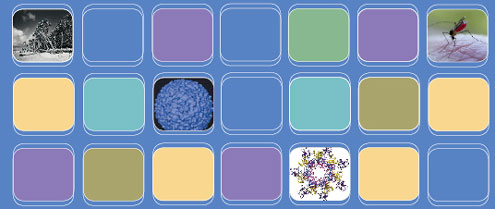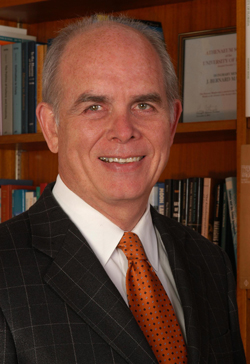|
|
Florida's Disease Control LeaderBy Dr. Bernie Machen, UF President downloadable pdf
Most Floridians already know all too well the dangers of animals and plants introduced from elsewhere on our shores. Formosan termites have damaged thousands of South Florida homes. Water-sopping Melaleuca trees continue to drain the Everglades. Hundreds of invasive plants, insects and animals threaten our crops, pocketbooks and native flora and fauna. Drawing on years of research and experience, federal and state officials have established effective control programs for many invasive species. That’s the good news. The bad news is, we are not prepared to deal with a more ominous threat already leaving its mark on the Sunshine State. This is the threat of new and reemerging diseases. With its warm climate, huge number of visitors and intense trade with South America, Florida may be more at risk than any other state to this threat. Yet the state soon to become the third largest in the country has no centralized research and response capability. That’s why the University of Florida has created the Emerging Pathogens Initiative. Emerging pathogens are either new or imported microorganisms that make people, animals or plants sick. The high-profile example of the moment is influenza H5N1, the virus that causes bird flu. Scientists worldwide are concerned H5N1 will mutate to become easily transmitted among humans. But even as the U.S. and other nations scramble to prepare for a potential pandemic, an increasing number of lesser-known but dangerous pathogens await their opportunity to wreak havoc. The same vulnerabilities that make Florida a magnet for invasive plants and animals also make it a target for new diseases. Our climactic variability, from tropical to temperate, means we can nurture a diversity of microorganisms. Eighty-five million tourists and thousands of immigrants cross our borders annually, each of them potentially accompanied by a new pathogen hitchhiker. The massive tonnage of agricultural products and goods that enter our airports and seaports is another likely disease vector. Florida’s frequent hurricanes, which can pick up and redistribute pathogens over long distances, only make matters worse. The history of citrus canker makes the danger plain. Canker was discovered on trees surrounding Miami International Airport in 1995. Despite early eradication efforts, it spread rapidly. A decade later, thanks in part to a spate of hurricanes, citrus canker has been found on trees as far north as Clay County near Jacksonville. That despite the state spending more than $477 million on eradication efforts aimed at preventing the foreign scourge from decimating Florida’s $9.1 billion citrus industry. And it doesn’t stop with canker. A new disease, citrus greening, potentially even more damaging than canker, was discovered in Florida in September. It has already spread to eight counties. Other newly arrived plant diseases include soybean rust, which first appeared in North Florida in 2004. Florida so far has been fairly lucky on the animal side, but this year’s appearance of canine influenza shows our weakness. There are numerous other dangers. Of course, human health is everyone’s primary concern. While Florida has so far escaped an epidemic, there’s no question that we have already seen the effects of other emerging and re-emerging pathogens. Eastern equine encephalitis and malaria have both sickened Floridians in recent years. West Nile is here, and ever present. Florida residents have also seen the effects of Norwalk virus, which made headlines when it sickened hundreds of passengers aboard a Florida-based cruise ship in 2002. We are vulnerable to many other pathogens. The list includes dengue fever, a mosquito-borne viral disease, and Q fever, which can spread to people from cattle and other farm animals. Q fever is on the rise nationally and Florida’s cattle farms offer prime breeding grounds. Of course, avian flu and SARS are also potential threats. It is worth pointing out that Florida could also be a target of bioterrorism. Residents know it from experience: The first person to die from an apparent anthrax attack was Bob Stevens, a tabloid photo editor in Boca Raton. Four years later, that incident and the other 2001 anthrax attacks remain under investigation. What can we do to protect ourselves? The first defense is vigilance. Doctors, nurses and other first-responders must remain on alert for the signs of a new disease outbreak. That said, the scale of the problem dwarfs the systems we have in place to cope with it. That is especially true at the research and response level. Statewide, there are only two or three research centers devoted to emerging pathogens. Yet they address only very specific elements of the picture, such as insect-borne diseases. There is no central clearinghouse for information, no central location for research, no central facility for response. We need one. The Emerging Pathogens Initiative at UF is the solution. The initiative is gathering together all the expertise and technology required to help anticipate, understand and prevent emerging pathogens. It serves as a point of contact and collaboration with the federal government and other states. And it will offer a “hot line” telephone and Web site for reporting of suspected outbreaks of any kind, one accessible to both citizens and professionals. UF is the natural home to such an initiative because of its enormous diversity of research, scholarly and clinical endeavors. We have large and successful colleges of medicine, veterinary medicine, agriculture, engineering and the general sciences. The initiative combines experts from all of these areas, linking specialists in fields as diverse as chemistry, microbiology, nanoscience, biotechnology, nursing, engineering and communications. The threat of new disease is great. But with a comprehensive, sustained effort of the kind this new UF initiative is mounting, Florida can successfully overcome the ever-increasing challenge of emerging infectious diseases.
Related Web site: |

